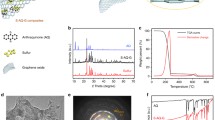Abstract—
To assess the possible degradation mechanisms of lithium–sulfur batteries during their cycling, cyclic voltammograms of sulfur electrode in normalized coordinates were analyzed. A capacity decrease at the low-voltage plateau is shown to correspond to the decrease in the active material amount, whereas decrease at the high-voltage plateau is characterized by a decrease in the reduction depth. The sulfur solubility in the dioxolane–dimethoxyethane mixture (1 : 1) is measured; it is about 0.2 M at room temperature. It is concluded that the shuttle transfer of polysulfides is not the only cause of the degradation: the transfer of dissolved sulfur also makes a significant contribution.










Similar content being viewed by others
Notes
The using of the stainless-steel electrode substrates was found [4] to accelerate the sulfur electrode self-discharge; however, this fact received no physical explanation.
REFERENCES
Manthiram, A., Fu, Y., Chung, S.-H., Zu, C., and Su, Y.-S., Rechargeable Lithium–Sulfur Batteries, Chem. Rev., 2014, vol. 114, p. 11751.
Kang, W., Deng, N., Ju, J., Li, Q., Wu, D., Ma, X., Li, L., Naebe, M., and Cheng, B., A review of recent developments in rechargeable lithium–sulfur batteries, Nanoscale, 2016, vol. 8, p.16541.
Kolosnitsyn, V.S. and Karaseva, E.V., Lithium–sulfur batteries: problems and solutions, Russ. J. Electrochem., 2008, vol. 44, p. 506.
Ryu, H.S., Ahn, H.J., Kim, K.W., Ahn, J.H., Cho, K.K., and Nam, T.H., Self-discharge characteristics of lithium/sulfur batteries using TEGDME liquid electrolyte, Electrochim. Acta, 2006, vol. 52, p. 1563.
Mikhaylik, Y., Electrolytes for lithium sulfur cells. US Pat. 7354680 (2008).
Zhao, M.-Q., Peng, H.-J., Tian, G.-L., Zhang, Q., Huang, J.-Q., Cheng, X.-B., Tang, C., and Wei, F., Hierarchical Vine-Tree-Like Carbon Nanotube Architectures: In-Situ CVD Self-Assembly and Their Use as Robust Scaffolds for Lithium–Sulfur Batteries, Adv. Mater., 2014, vol. 26, p. 7051.
Wang, J., Wu, Y., Shi, Z., and Wu, C., Mesoporous carbon with large pore volume and high surface area prepared by a co-assembling route for Lithium–Sulfur Batteries, Electrochim. Acta, 2014, vol. 144, p. 307.
Kuz’mina, E.V., Karaseva, E.V., Chudova, N.V., Mel’nikova, A.A., and Kolosnitsyn, V.S., On the Possibility of Determination of Thermodynamic Functions of the Li–S Electrochemical System Using the EMF Method, Russ. J. Electrochem., 2019, vol. 55, p. 978.
Song, M.-K., Cairns, E.J., and Zhang, Y., Lithium/sulfur batteries with high specific energy: old challenges and new opportunities, Nanoscale, 2013, vol. 5, p. 2186.
Ji, X. and Nazar, L.F., Advances in Li–S batteries, J. Mater. Chem., 2010, vol. 20, p. 9821.
Funding
This work is carried out with financial support from the Ministry of Sciences and Higher Education of RF.
Author information
Authors and Affiliations
Corresponding author
Ethics declarations
The authors declare that they have no conflict of interest.
Additional information
Translated by Yu. Pleskov
Rights and permissions
About this article
Cite this article
Kulova, T.L., Li, S.A., Ryzhikova, E.V. et al. Possible Causes of Lithium–Sulfur Battery Degradation. Russ J Electrochem 58, 391–397 (2022). https://doi.org/10.1134/S102319352205007X
Received:
Revised:
Accepted:
Published:
Issue Date:
DOI: https://doi.org/10.1134/S102319352205007X




